Text


Following publication of the final report there have been a number of questions and points for clarification about the findings and recommendations. We have collated those questions, along with our answers, on this page.
-
Did the Review set a higher bar for evidence than would normally be expected?
No, the approach to the assessment of study quality was the same as would be applied to other areas of clinical practice – the bar was not set higher for this Review.
Clarification:
The same level of rigour should be expected when looking at the best treatment approaches for this population as for any other population so as not to perpetuate the disadvantaged position this group have been placed in when looking for information on treatment options.
The systematic reviews undertaken by the University of York as part of the Review’s independent research programme are the largest and most comprehensive to date. They looked at 237 papers from 18 countries, providing information on a total of 113,269 children and adolescents.
All of the University of York’s systematic review research papers were subject to peer review, a cornerstone of academic rigour and integrity to ensure that the methods, findings, and interpretation of the findings met the highest standards of quality, validity and impartiality.
-
Did the Review reject studies that were not double blind randomised control trials in its systematic review of evidence for puberty blockers and masculinising / feminising hormones?
No. There were no randomised control studies identified in the systematic reviews, but other types of studies were included if they were well designed and conducted.
Clarification:
The Review commissioned the University of York to undertake an independent research programme to ensure the work of the Review and its recommendations were informed by the most robust existing evidence. This included a series of systematic reviews which brought together, analysed and evaluated existing evidence on a range of issues relating to the care of gender-questioning children and young people, including epidemiology, treatment approaches and international models of current practice.
Randomised control trials are considered the gold standard in relation to research, but there are many other study designs that can give valuable information. Explanatory Box 1 (pages 49-51 of the final report) discusses in more detail the different kinds of studies that can be used, and how to decide if a study is poorly designed or biased.
Blinding is a separate issue. It means that either the patient or the researcher does not know if the patient is getting an active treatment or a ‘control’ (which might be another treatment or a placebo). Patients cannot be blinded as to whether or not they are receiving puberty blockers or masculinising / feminising hormones, because the effects would rapidly become obvious. Good RCTs can be conducted without blinding.
The University of York’s systematic review search did not identify any RCTs, blinded or otherwise, but many other studies were included. Most of the studies included were called ‘cohort studies’. Well-designed and executed high quality cohort studies are used in other areas of medicine, and the bar was not set higher for this review; even so the quality of the studies was mostly only assessed as moderate.
-
Did the Review reject 98% of papers demonstrating the benefits of affirmative care?
No. Studies were identified for inclusion in the synthesis (conclusions) of the systematic reviews on puberty blockers and masculinising/feminising hormones on the basis of their quality. This was assessed using a standard quality assessment tool appropriate to the types of study identified. All high quality and moderate quality reviews were included in the synthesis of results. This totalled 58% of the 103 papers.
Clarification:
The Newcastle-Ottawa scale (a standard appraisal tool) was used to compare the studies. This scores items such as participant selection, comparability of groups (how alike they are), the outcomes of the studies and how these were assessed (data provided and whether it is representative of those studied). High quality studies (scoring >75%) would score well on most of these items; moderate quality studies (scoring >50% – 75%) would miss some elements (which could affect outcomes); and low-quality studies would score 50% or less on the items the scale looked at. A major weakness of the studies was that they did not have adequate follow-up – in many cases they did not follow young people for long enough for the long-term outcomes to be understood.
Because the ranking was based on how the studies were undertaken (their quality and execution), low quality research was removed before the results were analysed as the findings could not be completely trusted. Had an RCT been available it would also have been excluded from the systematic review if it was deemed to be of poor quality.
The puberty blocker systematic review included 50 studies. One was high quality, 25 were moderate quality and 24 were low quality. The systematic review of masculinising/feminising hormones included 53 studies. One was high quality, 33 were moderate quality and 19 were low quality.
All high quality and moderate quality reviews were included, however as only two of the studies across these two systematic reviews were identified as being of high quality, this has been misinterpreted by some to mean that only two studies were considered and the rest were discarded. In reality, conclusions were based on the high quality and moderate quality studies (i.e. 58% of the total studies based on the quality assessment). More information about this process in included in Box 2 (pages 54-56 of the final report)
-
Has the Review recommended that no one should transition before the age of 25 and that Gillick competence should be overturned.
No. The Review has not commented on the use of masculinising/feminising hormones on people over the age of 18. This is outside of the scope of the Review. The Review has not stated that Gillick competence should be overturned.
The Review has recommended that:
“NHS England should ensure that each Regional Centre has a follow through service for 17-25-year-olds; either by extending the range of the regional children and young people’s service or through linked services, to ensure continuity of care and support at a potentially vulnerable stage in their journey. This will also allow clinical, and research follow-up data to be collected.”
This recommendation only relates to people referred into the children and young people’s service before the age of 17 to enable their care to be continued within the follow-through service up to the age of 25.
Clarification:
Currently, young people are discharged from the young people’s service at the age of 17, often to an adult gender clinic. Some of these young people have been receiving direct care from the NHS gender service (GIDS as was) and others have not yet reached the top of the waiting list and have “aged out” of the young people’s service before being seen.
The Review understands that this is a particularly vulnerable time for young people. A follow-through service continuing up to age 25, would remove the need for transition (that is, transfer) to adult services and support continuity of care and continued access to a broader multi-disciplinary team. This would be consistent with other service areas supporting young people that are selectively moving to a ‘0-25 years’ service to improve continuity of care.
The follow-through service would also benefit those seeking support from adult gender services, as these young people would not be added to the waiting list for adult services and, in the longer-term, as more gender services are established, capacity of adult provision across the country would be increased.
People aged 18 and over, who had not been referred to the NHS children and young people’s gender service, would still be referred directly to adult clinics.
-
Is the Review recommending that puberty blockers should be banned?
No. Puberty blocker medications are used to address a number of different conditions. The Review has considered the evidence in relation to safety and efficacy (clinical benefit) of the medications for use in young people with gender incongruence/gender dysphoria.
The Review found that not enough is known about the longer-term impacts of puberty blockers for children and young people with gender incongruence to know whether they are safe or not, nor which children might benefit from their use.
Ahead of publication of the final report NHS England took the decision to stop the routine use of puberty blockers for gender incongruence / gender dysphoria in children. NHS England and National Institute for Health and Care Research (NIHR) are establishing a clinical trial to ensure the effects of puberty blockers can be safely monitored. Within this trial, puberty blockers will be available for children with gender incongruence/ dysphoria where there is clinical agreement that the individual may benefit from taking them.
Clarification:
Puberty blockers have been used to suppress puberty in children and young people who start puberty much too early (precocious puberty). They have undergone extensive testing for use in precocious puberty (a very different indication from use in gender dysphoria) and have met strict safety requirements to be approved for this condition. This is because the puberty blockers are suppressing hormone levels that are abnormally high for the age of the child.
This is different to stopping the normal surge of hormones that occur in puberty. Pubertal hormones are needed for psychological, psychosexual and brain development, and there is not yet enough information on the risks of stopping the influence of pubertal hormones at this critical life stage.
When deciding if certain treatments should be routinely available through the NHS it is not enough to demonstrate that a medication doesn’t cause harm, it needs to be demonstrated that it will deliver clinical benefit in a defined group of patients.
Over the past few years, the most common age that young people have been receiving puberty blockers in England has been 15 when most young people are already well advanced in their puberty. The new services will be looking at the best approaches to support young people through this period when they are still making decisions about longer-term options.
-
Has the Review recommended that social transition should only be undertaken under medical guidance?
The Review has advised that a more cautious approach around social transition needs to be taken for pre-pubertal children than for adolescents and has recommended that:
“When families/carers are making decisions about social transition of pre-pubertal children, services should ensure that they can be seen as early as possible by a clinical professional with relevant experience.”
Parents are encouraged to seek clinical help and advice in deciding how to support a child with gender incongruence and should be prioritised on the waiting list for early consultation on this issue. This should include discussion of the risks and benefits and the voice of the child should be heard. It will be important that flexibility is maintained, and options remain open.
Clarification:
Although the University of York’s systematic review found that there is no clear evidence that social transition in childhood has positive or negative mental health outcomes, there are studies demonstrating that for a majority of young children presenting with gender incongruence, this resolves through puberty. There is also evidence from studies of young people with differences of sex development (DSD) that sex of rearing seems to have some influence on eventual gender outcome, and it is possible that social transition in childhood may change the trajectory of gender identity development for children with early gender incongruence. Living in stealth from early childhood may also lead to stress, particularly as puberty approaches.
There is relatively weak evidence for any effect of social transition in adolescence. The Review recognises that for adolescents, exploration is a normal process, and rigid binary gender stereotypes can be unhelpful. Many adolescents will go through a period of gender non-conformity in terms of outward expressions (e.g. hairstyle, make-up, clothing and behaviours). They also have greater agency in how they present themselves and in their decision-making.
Young people and young adults have spoken positively about how social transition helped to reduce their gender dysphoria and feel more comfortable in themselves. They identified that space to talk about socially transitioning and how to handle conversations with parents/carers and others would be helpful. The Review has therefore advised that it is important to try and ensure that those already actively involved in the young person’s welfare provide support in decision making and that plans are in place to ensure that the young person is protected from bullying and has a trusted source of support.
Further detail can be found in Chapter 12 of the Final Report.
-
Did the Review speak to any gender-questioning and trans people when developing its recommendations?
Yes, the Review has been underpinned by an extensive programme of proactive engagement, which is described in Chapter 1 of the report. The Review has met with over 1000 individuals and organisations across the breadth of opinion on this subject but prioritised two categories of stakeholders:
People with relevant lived experience (direct or as a parent/carer) and organisations working with LGBTQ+ children and young people generally.
Clinicians and other relevant professionals with experience of and/ or responsibility for providing care and support to children and young people within specialist gender services and beyond.
A mixed-methods approach was taken, which included weekly listening sessions with people with lived experience, 6-weekly meetings with support and advocacy groups throughout the course of the Review, and focus groups with young people and young adults.
Reports from the focus groups with young people with lived experience are published on the Review’s website and the learning from these sessions and the listening sessions are represented in the final report.
The Review also commissioned qualitative research from the University of York, who conducted interviews with young people, young adults, parents and clinicians. A summary of the findings from this research is included as appendix 3 of the final report.
-
What is the Review’s position on conversion therapy?
Whilst the Review’s terms of reference do not include consideration of the proposed legislation to ban conversion practices, it believes that no LGBTQ+ group should be subjected to conversion practice. It also maintains the position that children and young people with gender dysphoria may have a range of complex psychosocial challenges and/or mental health problems impacting on their gender-related distress. Exploration of these issues is essential to provide diagnosis, clinical support and appropriate intervention.
The intent of psychological intervention is not to change the person’s perception of who they are but to work with them to explore their concerns and experiences and help alleviate their distress, regardless of whether they pursue a medical pathway or not. It is harmful to equate this approach to conversion therapy as it may prevent young people from getting the emotional support they deserve and make clinicians fearful of providing this group of children and young people the same care as is afforded to other children and young people.
No formal science-based training in psychotherapy, psychology or psychiatry teaches or advocates conversion therapy. If an individual were to carry out such practices they would be acting outside of professional guidance, and this would be a matter for the relevant regulator.
==
Like any religious fanatics, pathological liars like "Erin" Reed and "Alejandra" Carballo still won't stop lying, since it's all they have. But their disciples should really be noticing how they've been directly refuted.
#Cass review#Cass report#Hilary Cass#Dr. Hilary Cass#disinformation#misinformation#pathological liars#Erin Reed#Alejandra Carabello#Michael Hobbes#medical scandal#medical corruption#medical malpractice#gender affirming care#gender affirming healthcare#gender affirmation#compulsive liars#gender fanatics#gender cult#gender ideology#gender identity ideology#queer theory#intersectional feminism#puberty blockers#cross sex hormones#wrong sex hormones#religion is a mental illness
4 notes
·
View notes
Text

2 notes
·
View notes
Text







By: Christopher F. Rufo and Luke Rosiak
Published: Apr 22, 2024
Recent headlines about UCLA School of Medicine suggest that the institution has lost its focus. Instead of brushing up on organic chemistry, its students were subjected to lessons on “Indigenous womxn” and “two-spirits.” Future doctors had to take a class on “structural racism” and were led in a “Free Palestine” chant by a Hamas-praising guest speaker. The school made plans to segregate students by race for courses on left-wing ideology, and two of its psychiatry residents championed “revolutionary suicide.”
Why has the school charted this course? One reason is its commitment to diversity, equity, and inclusion ideology. UCLA has a DEI program called “Cultural North Star,” and at the medical school, it is led by Natalie J. Perry, whose official title is Cultural North Star Lead. Her UCLA biography says that her job is to “embed our aspirational Cultural North Stars [sic] value [sic] in our organizational DNA.” UCLA honored Perry last month for teaching students to “do what’s right,” saying her “empathy and radical listening” are to thank for her “success as an educator and a leader.”
According to a Daily Wire and City Journal investigation, however, Perry’s academic career is based on fraud. Perry published her Ph.D. dissertation in 2014 at the University of Virginia about college diversity programs. An analysis of the paper found it ridden with the worst sort of plagiarism, reproducing large swaths of text directly from several other authors, without proper citations. The scale of the plagiarism suggests that Perry lacks both ethics and competence and raises questions about academic programs that push DEI.
Perry’s dissertation lifted passages from ten other papers. In key portions of her text, she copied almost every paragraph from other sources without attribution. She fails even to mention at least four of the ten plagiarized papers anywhere in her dissertation.
Let’s review some examples.
The first three pages of Perry’s paper, “Faculty Perceptions of Diversity at a Highly Selective Research-Intensive University,” suggest that she did not even bother to read beyond the first page of papers from which she stole. Her dissertation’s second sentence reproduces verbatim part of a sentence on the first page of a paper by Adrianna Kezar, Peter Eckel, Melissa Contreras-McGavin, and Stephen John Quaye. Her third paragraph, without citation, lifts more than 100 words from the first page of a paper by Angela Locks, Sylvia Hurtado, Nicholas Bowman, and Leticia Oseguera.
Each colored portion of the below text was taken from a different author:
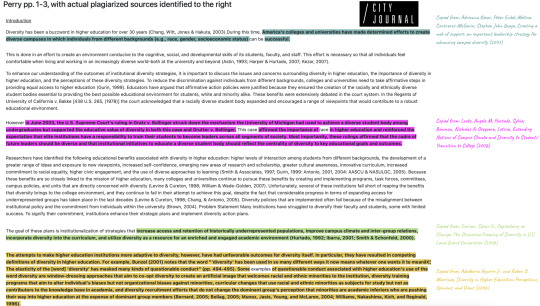

In some cases when Perry did include parenthetical citations, she wasn’t citing the papers whose text she had lifted. Instead, she simply reproduced the citations included in those stolen excerpts.

Take the above paragraph, which ends with “(Bernard, 2005; Bollag, 2005; Munoz, Jasis, Young, and McLaren, 2004; Williams, Nakashima, Kich, and Reginald, 1996).” Perry was not synthesizing those authors. Instead, the citation was part of Adalberto Aguirre and Ruben Martinez’s paper, from which she apparently copied and pasted, without attribution.
A core part of Perry’s dissertation involved summarizing work done by professors Robert Quinn and John Rohrbaugh. Instead of citing them directly, however, Perry cribbed summaries from other academics. Perry copied and pasted almost all of a nearly thousand-word passage from a paper by Chad Hartnell, Amy Yi Ou, and Angelo Kinicki, without quoting the authors.
Consider, for example, the following excerpt from Perry’s dissertation. The italicized portions were taken verbatim from Hartnell, Yi Ou, and Kinicki’s paper:
The CVF is widely used in organizational literature (Ostroff et al., 2003). Measures of organizational culture that directly or indirectly assess the CVF have been administered in over 10,000 organizations globally (Cameron et al., 2006) within the following academic disciplines: management, marketing, supply-chain management, accounting, social services, hospitality, and health care. Further, the reliability and content validity of Cameron and Ettington's (1988) measure of the CVF has been empirically supported in studies utilizing multitrait-multimethod analysis (Quinn & Spreitzer, 1991), multidimensional scaling (Howard, 1998), and structural equation modeling (Kalliath, Bluedorn, & Gillespie, 1999). Surprisingly, prior to 2011, there had been limited assessment of the theoretical foundation of the CVF despite its reported content validity and widespread use in research and practice.
The rest of Perry’s analysis of Quinn and Rohrbaugh’s work is largely copied, unquoted and unattributed, from a 2003 paper by John Smart. Below are pages 13 and 14 of Perry’s paper, outlining its “Theoretical Framework,” with the italicized text coming directly from Smart:
To develop this theory Quinn and Rohrbaugh (1983) asked a panel of distinguished organizational theorists to evaluate the similarity between every possible pair of 39 indexes of organizational effectiveness derived from Campbell’s (1977) exhaustive synthesis of criteria used to assess the performance of organizations. The results of this analysis revealed three basic dimensions underlying the judgments of respondents. The first dimension is organizational focus, which distinguishes organizations that have an internal emphasis on the development of people from those that have an external focus on the development of the organization. The second dimension is organizational structure, which distinguishes between organizations that have an emphasis on stability and control from those that have an emphasis on flexibility and innovation. The third dimension is organizational means and ends, which distinguish between organizations that emphasize processes such as planning and establishing goals from those that emphasize resulting outcomes such as productivity and efficiency.
In a section titled “Positioning Diversity Leadership in Higher Education,” Perry copies almost every sentence from one of several other papers. In no case does she credit the actual source:
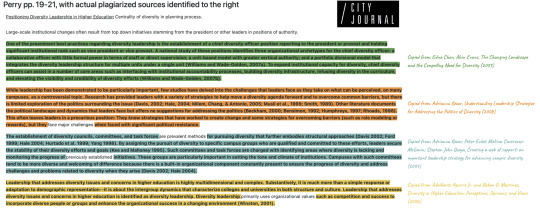
Finally, in a section on organizational culture, Perry duplicates language from a variety of other authors:
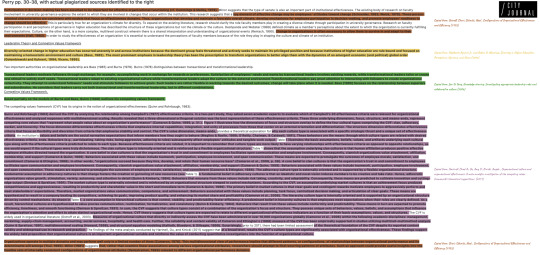
Perry presented her paper as “qualitative” research because she chatted with what appear to be ten members of her colleagues at the University of Virginia who sat on the faculty-retention taskforce and counted their musings as “data.” But when the paper gets to this section, where plagiarism wasn’t possible, Perry includes the following jumbled passage that includes a glaring spelling error:
The positionality of the participants informed the perspective on the origins of the commission. /in response to the needs of the varios [sic] stakeholders within the university, the commission addressed issues of diversity on the faculty, undergraduate, graduate, and university level.
The section of original text suggests that her plagiarism could be used to mask glaring academic deficiencies. Moreover, Perry in her references section fails to list some of the papers that she cites parenthetically in the body of the dissertation—a telltale sign that she had simply copied those citations from somewhere else. Legitimate academic inquiry would not excuse such shoddy work.
Perry and UCLA did not return requests for comment.
Entrepreneur Mark Cuban recently argued that DEI policies don’t necessarily lower an organization’s expectations. But for Harvard, UVA, and UCLA Medical School—where Perry earned her master’s, Ph.D., and DEI position, respectively—this is evidently not the case. These institutions have dramatically lowered expectations for favored groups and pushed a cohort of “scholars” through the system without enforcing basic standards of academic integrity.
Ultimately, Natalie Perry is to blame for her misconduct. But these institutions of higher learning share some fault for permitting such shoddiness to stand unchallenged.
==
These are the same people who want to lecture us how much more morally enlightened they are than we are.
#Christopher Rufo#Christopher F. Rufo#Luke Rosiak#Natalie Perry#academic corruption#plagiarism#academic fraud#diversity equit#diversity equity and inclusion#DEI must die#DEI#diversity#equity#inclusion#diversity hire#DEI bureaucracy#religion is a me#religion is a mental illness
4 notes
·
View notes
Text
Gallagher: I'd like to follow up on that, maybe attempt to simplify it. We are fortunate to live in a democracy, and Dr. Wallander, would you say that the United States military in general holds itself to the highest ethical standards? Moral and ethical standards?
Wallander: Yes, congressman.
Gallagher: Would you say that our military takes great effort to avoid civilian casualties wherever possible?
Wallander: Yes, congressman.
Gallagher: Do you believe the United States intentionally targets civilians?
Wallander: I believe the US military does not intentionally target civilians.
Gallagher: And in Israel, we have a vibrant democracy as well, this is a great thing. Do you believe that the Israeli Defence Forces hold themselves to a high moral and ethical standard, just as the United States does?
Wallander: I do believe that the Israeli Defence Forces hold themselves to that high standard.
Gallagher: And Israel does not target civilians and takes steps to avoid civilian casualties wherever possible, correct?
Wallander: I believe that is a true statement, sir.
Gallagher: And is there any evidence at present that they are-- you emphasized in your testimony that they have a responsibility to protect civilians. I agree, I think they're doing-- going to great lengths to do just that and to uphold international law. Is there any that they are violating international law?
Wallander: I am not aware of any evidence that they are deliberately targeting civilians.
Gallagher: And so, contrast that. The high moral and ethical standards of the United States military and our allies in Israel, with Hamas. Hamas is a terrorist organization, correct?
Wallander: Yes, congressman.
Gallagher: And Hamas does not care about human life, including the civilians in Gaza?
Wallander: Worse, Hamas exploits others' concern for civilian life by placing their capabilities and their fighters, protected by human shields.
Gallagher: That was going to be my next question, you anticipated the use of human shields. And many civilians in Gaza have died from Hamas rockets landing inside Gaza in Hamas' attacks on civilians. Correct?
Wallander: I believe there have been such validated incidents, yes, congressman.
Gallagher: The only thing I'm curious about is, Hamas could, if we applied the same standard, they have a responsibility to protect human life, Hamas could surrender today, release all of the hostages and the war presumably would be over. Correct?
Wallander: If Hamas ended their war against Israel, the conflict could be over today.
Gallagher: A final question on this front. Do you want Hamas to be removed from control of Gaza or would you like to see Hamas regain control of Gaza, at the risk of another October 7th-type massacre?
Wallander: The administration fully supports Israel's goal of destroying Hamas' ability to conduct these operations.
Gallagher: Thank you, I appreciate that.
[ Full video. ]
==
Exterminate Hamas.
#Celeste A. Wallander#Celeste Wallander#Hamas#hamas terrorism#oct 7#october 7 massacre#israel#gaza#islamic terrorism#islam#release the hostages#exterminate hamas#US military#Israel Defense Forces#hamas war crimes#religion is a mental illness
9 notes
·
View notes
Text
By: James Crisp
Published: Apr 13, 2024
Belgium and the Netherlands have become the latest countries to question the use of puberty blockers on children after the Cass Review warned of a lack of research on the gender treatment’s long-term effects.
Britain has become the fifth European nation to restrict the use of the drug to under 18s after initially making them part of their gender treatments.
Their use was based on the “Dutch protocol” - the term used for the practice pioneered in the Netherlands in 1998 and copied around the world, of treating gender dysphoric youth using puberty blockers.
The NHS stopped prescribing the drug, which is meant to curb the trauma of a body maturing into a gender that the patient does not identify with this month.
In Belgium, doctors have called for gender treatment rules to be changed.
‘Last resort’
“In our opinion, Belgium must reform gender care in children and adolescents following the example of Sweden and Finland, where hormones are regarded as the last resort,” the report by three paediatricians and psychiatrists in Leuven said.
Figures from the Netherlands and the United Kingdom show that more than 95 per cent of individuals who initiated puberty inhibition continue with gender-affirming treatments,” the report by P Vankrunkelsven P, K Casteels K and J De Vleminck said.
“However, when young people with gender dysphoria go through their natural puberty, these feelings will only persist in about 15 per cent.”
The report was published after a 60 per cent rise in the number of Belgium teenagers taking the blockers to stop the development of their bodies. In 2022, 684 people between the ages of nine and 17 were prescribed the drug compared to 432 in 2019, the De Morgen newspaper reported in 2019.
Pressure is also building in the neighbouring Netherlands to look again at their use. The parliament has ordered research into the impact of puberty blockers on adolescent’s physical and mental health.
Dutch Protocol
The Telegraph understands that the Amsterdam Center of Expertise on Gender Dysphoria, where the Protocol originated, is set to make a statement on the use of puberty blockers next week.
“I too thought that the Dutch gender care was very careful and evidence-based. But now I don’t think that any more,” Jilles Smids, a postdoctoral researcher in medical ethics at Erasmus University in the Netherlands, told The Atlantic.
Attitudes in the Netherlands have hardened against trans rights, with a bill to make it easier for people to legally change their gender being held up in parliament.
The Cass Review said that the NHS had moved away from the restrictions of the original Dutch Protocol, and researchers in Belgium have also demanded those restrictions be reintroduced.
Belgium is regarded as one of the most trans-friendly countries in Europe. A minister in the government is transgender and people have been able to legally change their gender without a medical certificate for the past five years.
But the hard-Right Vlaams Belang party is currently leading the polls ahead of national and European elections in June.
It has called for “hormone therapy and sex surgery to be halted for underage patients until clear and concrete research has been carried out.”
‘Greatest ethical scandals’
In March, a report in France described sex reassignment in minors as potentially “one of the greatest ethical scandals in the history of medicine”.
Conservative French senators plan to introduce a bill to ban gender transition treatments for the under-18s.
On Monday, the Vatican’s doctrine office published a report that branded gender surgery a grave violation of human dignity on a par with euthanasia and abortion.
Finland was one of the first countries to adopt the Dutch Protocol but realised many of its patients did not meet the Protocol’s strict eligibility requirements for the drugs.
It restricted the treatment in 2020 and recommended psychotherapy as the primary care.
Sweden restricted hormone treatments to “exceptional cases” two years later. In December, Norwegian authorities designated the medicine as “under trial”, which means they will only be prescribed to adolescents in clinical trials.
Denmark is finalising new guidelines limiting hormone treatments to teenagers who have had dysphoria since early childhood.
In 2020, Hungary passed a law banning gender changes on legal documents.
“The import and the use of these hormone products are not banned, but subject to case by case approval, however, it is certain that no authority would approve such an application for people under 18,“ a spokesperson told the Telegraph.
In August, Russia criminalised all gender reassignment surgery and hormone treatments.
[ Via: https://archive.today/0oU9Z ]
==
It's kind of ironic that in the early 20th century, Russia was the center of the scientific corruption and scandal that was Lysenkoism, where ideology trumped reality. Millions suffered and died as a result of denying biological reality.
The process of cementing Lysenkoism was eerily familiar.
https://en.wikipedia.org/wiki/Lysenkoism
On August 7, 1948, at the end of a week-long session organized by Lysenko and approved by Stalin, the Academy of Agricultural Sciences announced that Lysenkoism would henceforth be taught as "the only correct theory." Soviet scientists were required to denounce any work that contradicted Lysenko, and criticism was denounced as "bourgeois" or "fascist".
Today, countries like the US, Canada and Australia are up to their armpits in a modern-day form of Gender Lysenkoism.
#James Crisp#Belgium#Netherlands#Dr. Hilary Cass#Hilary Cass#Cass Report#Cass Review#puberty blockers#medical corruption#medical scandal#medical malpractice#cross sex hormones#wrong sex hormones#gender affirming care#gender affirming healthcare#NHS England#National Health Service#religion is a mental illness#gender pseudoscience
6 notes
·
View notes
Text

"God gave birds wings, but he didn't forbid them from flying.
He blessed cheetahs with speed, but he never forbad them from outrunning their prey.
He did, however, give humans a brain and insisted that they not use it."
Proverbs 3:5-6
Trust in the Lord with all thine heart; and lean not unto thine own understanding.
In all thy ways acknowledge him, and he shall direct thy paths.
2 Corinthians 10:5
Casting down imaginations, and every high thing that exalteth itself against the knowledge of God, and bringing into captivity every thought to the obedience of Christ
#christianity#bible#bible study#mindless#blind faith#faith#faith is not a virtue#faith is a vice#blind obedience#mindless obedience#credulity#religion#don't think for yourself#religion is a mental illness
35 notes
·
View notes
Text

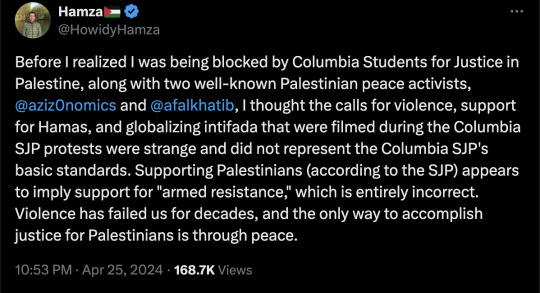
By: Hamza Howidy, Palestinian from Gaza City
Published: Apr 25, 2024
Protests are spreading across the United States at college campuses, where university students are gathering in the name of Palestinian rights and occupying campus spaces with tents. Sadly, not everyone who purports to support Palestinians is truly interested in safeguarding our rights.
It pains me to say this as a Palestinian from Gaza. As my home is destroyed and too many killed, I never thought I would find myself criticizing those speaking up. And yet, I cannot be silent about what I am seeing. The truth is that the manner in which many gather to voice their support for Palestinians does more to hurt our cause than help it.
You know what would help the Palestinians in Gaza? Condemning Hamas' atrocities. Instead, the protesters routinely chant their desire to "Globalize the Intifada." Apparently they do not realize that the Intifadas were disastrous for both Palestinians and Israelis, just as October 7 has been devastating for the people of Gaza.
They should be speaking up for the innocent victims of Hamas—both Palestinian and Israeli. Instead, they endorse Hamas's ideology with posters announcing resistance "by any means necessary" and chants of "from the river to the sea," effectively glorifying the Al-Qassam brigades, Hamas' military wing, whose ideology is entirely based on the elimination of more than 6 million Israelis from the land.
I assumed individuals who initiated these slogans were uninformed about what they were advocating for. I saw the LGBTQ flag frequently flown among people chanting lines from Hamas's charter, and I initially wanted to educate them, to warn them that the group they are honoring would most likely toss them from the top of a building or murder them like they did to Mahmoud Ishtiwi, a Hamas commander accused of homosexuality. Hamas harasses women who don't cover their heads. Hamas tortures those who demonstrate against their authoritarian rule, as they did me when I protested.
All of this seems to be lost on the people who have named themselves our allies, to our misfortune.
Hate speech on college campuses starting with the one at Columbia has recently reached a frightening pitch. I've seen people yelling antisemitic things at Jewish students, including "Jews go back to Poland" and other horrible phrases. It has deteriorated to the point that Jews are no longer attending university classes due to the current hostile environment, and they are attending their classes online to avoid the demonstrators.
It's unconscionable. But it's not just the antisemitism that has me despairing. It's the hypocrisy. Where were these caring young people when Hamas took over Gaza and slaughtered hundreds of Gazans, or when Hamas held 2 million Gazans captive for more than 17 years? Why didn't they speak out about the fact that Hamas led Gazans into this conflict, which resulted in more than 30,000 dead and 80,000 injured, according to Gazan municipal authorities? Where were they when Hamas's failed missiles claimed the lives of hundreds of Gazans on October 17, or when Hamas murdered young people in order to steal aid and resell it to Gazans at massively inflated prices?
The only conclusion that can be drawn from these demonstrators' silence concerning Hamas' atrocities and their antisemitic chanting is that they are not concerned with protecting Palestinians. They are out in their tents because of a hatred of Jews and Israelis.
As a Gazan and as a Palestinian, I want the protesters and the organizers of these protests to know that their hateful speech harms us. The Jewish person or Israeli you are intimidating during your rally may be the granddaughter of a Holocaust survivor or a family member of an Israeli slain or abducted by Hamas on October 7. These folks would be your partners if the protests were about achieving lasting peace and justice for Palestinians and Israelis.
I do not accept hateful speech or terrorist chants, and all of these foolish dreams about eradicating Israel are disgusting—and will never be achieved. Both of us—Palestinians and Israelis—are here to stay.
But the protesters aren't interested in peace. Some of the groups have been blocking Palestinian peace activists like me—and I am from Gaza, the very place they claim to care about! Instead of blocking peace activists, they should be inviting us to join these protests and guide them in the right direction—a place without hatred with a focus on calling for the release of the hostages who have been held captive by Hamas for more than 210 days.
If the protesters cared about Palestinians, they would have one central demand: Hamas must surrender, because we have all suffered from Hamas and can no longer live under the rule of a terrorist group. Only then can a ceasefire be achieved.
Hamza Howidy is a Palestinian from Gaza City. He is an accountant and a peace advocate.
==
Told you so.
I've been calling these protestors "pro-Hamas" not "pro-Palestine" for months. I've invited dozens to condemn Hamas and none of them will. The "ceasefire" they want is for Israel to surrender so Hamas can murder them all, as they've consistently promised to.
Imagine people who pretend to want a "ceasefire" not just chanting for "intifada" (violence) and celebrating barbarous Islamic terrorism but blocking actual Palestinian peace activists. This was never about peace. It still isn't. They're useful idiots whose antisemitism is being used by Islamic supremacists to undermine western society.
#Hamza Howidy#Gaza#free Gaza#antisemitism#israel#pro palestine#palestine#hamas supporters#islamic terrorism#pro hamas#terrorism supporters#intifada#intifada revolution#useful idiots#by all means#islam#islamic supremacy#religion#religion is a mental illness
21 notes
·
View notes
Text


youtube
Andrew Doyle: So the Gay Men's Network official response to the Cass review is now live, it is subtitled "Towards a Vision of Post-Gender Gay Rights," and it describes the Cass review as a devastating account of an unprecedented homophobic medical scandal in the NHS and private health sphere. And here to discuss it, I'm joined by Dennis Kavanagh, the lawyer and director of the Gay Men's Network. Welcome Dennis.
So, let's start with your report from the Gay Men's Network. What is your response, in a nutshell, to the Cass review?
Dennis Kavanagh: Our response is basically this. That this is a sad day for the gay rights movement. Cass is a reality check and it's shown us that for decades now, homosexuality has in effect been medicalized at the NHS. You and I've spoken before about the fact that 90% of the kids at the Tavistock were same sex attracted.
Doyle: Which has been confirmed by the Cass review.
Kavanagh: Precisely that. So, we say this. We say this is a shocking indictment of gay politics and of the gay rights movement generally. Particularly in view of the fact that the very people who should have been protecting gay youth, principally Stonewall, weren't just abandoned, didn't just abandon their post, they joined the opposition forces, when they should have been standing up for these kids.
Doyle: And what do you think their response will be now? I know Stonewell put out a kind of unclear statement, sort of saying we accept the findings of the Cass review. But it wasn't that clear, was it?
Kavanagh: They've had two statements. They put out a tweet saying that they accepted the Cass review. Their own supporters then turned on them fairly viciously to express their displeasure with it. They've now released a longer statement in which they're scrabbling around in the Cass review for crumbs of hope, saying, well it's not a blanket ban on puberty blockers because there're still a possibility of a clinical trial, for example.
But Stonewall need to get real on this. This is over now. Dr. Cass has called time on this homophobic medical scandal. The sitting Secretary of State, the shadow Secretary of State for Health have accepted Cass. It's time for Stonewall to do the same, actually show some leadership and some concern for gay youth.
I would make this point if I may, Andrew. That statement from Stonewall, it didn't have the word gay or lesbian in it once. That's a powerful indication there.
Doyle: Okay, well it might be worth just reading out what Stonewall said they said, "Dr. Cass has not called for adolescents to have their right to their Identity or autonomy removed. Nor did Dr. Cass recommend the blanket ban on social transitioning for children of any age. Most significantly, Dr. Cass did not support unilateral 'outing' of trans young people by schools. There are clear gaps between recommendations and practical policy, and we're already hearing early reports of Dr Cass's analysis of - and recommendations about - social transitioning being used to challenge trans people's right to Identity."

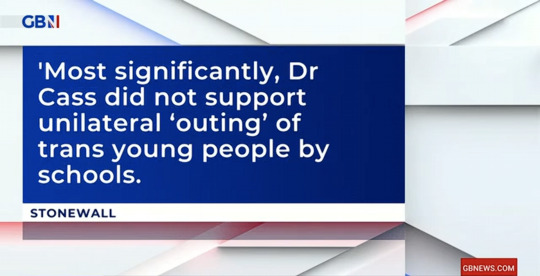
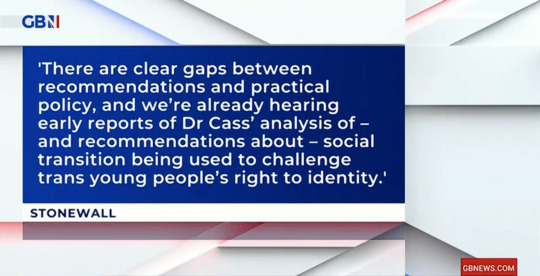
But it's interesting as you say, Dennis, they don't mention the key issue here, which is their failure to stand up for gay and lesbian youth.
Kavanagh: Yeah, and what a gloss on the Cass report that is. If you look at what the Cass report actually says that social transitioning, says where this occurs, there should be reference to a clinician almost immediately because it's not a neutral act. You won't find that in the Stonewall response, because Stonewall don't seem to care about concretizing cross-sex ideation, predominantly among homosexual young population.
Doyle: But they have bought into this idea that everyone is born with a gender identity and that that might be misaligned to the body. So, this is a belief system that is now so embedded in Stonewall, isn't it time that Stonewall was just no longer taken seriously?
Kavanagh: I entirely agree. In 2015, Stonewall added the T to the LGB under the leadership of Ruth Hunt, who promised everyone she wasn't going to do that but performed a vault fast. Which is why she's now facing, in the wake of this medical scandal, she's now facing a petition started by the author Simon Edge, which is coming up on, I think, 16,000-odd signatures, a petition to remove her from the House of Lords.
Doyle: I know you say that it's time's up now thanks to Cass, but isn't it going to be tough? And the reason I say that is there are still so many prominent gay and lesbian celebrities and groups and politicians, who are saying that they're standing up for Stonewall, who are standing up for the idea that kids may have a misaligned soul and body. And actually, given the prominence of those people, maybe voices like yours are the minority here.
Kavanagh: Well, that may or may not be the case, but what matters here is not the weight of numbers. What matters here is who is right about safeguarding these children. And if I'm one voice in 100, I don't care, if I'm right. I do think Stonewall are losing purchase in the public sphere, though. I do think politicians are beginning to realize that something has gone very, very seriously wrong here. It is heartening to see a cross-party consensus of serious politicians from the main, the larger parties embracing Cass and saying that a post-Cass NHS should effectively entirely rid itself of this poisonous ideology.
Doyle: And will it be taken up by the politicians? I mean, I know Alicia Kearns was adding an amendment to the criminal justice bill to try and ban what she calls "trans conversion therapy," but actually Cass specifically refers to this, saying that actually, this should not be mistaken, this should not be confused in the way that she's doing. She doesn't name Alicia Kearns, but she says that it is a common confusion.
Kavanagh: Yeah, and we've drawn this to Alicia Kearns's attention. We actually produced a briefing notes at Gay Men's Network on that amendment to the criminal justice bill. We've drawn Dr. Cass's comments to her attention. So far, we've heard absolutely nothing. Miss Kearns seems to think it's fine to speak over and speak for gay men, when gay men are telling her, look there's a problem with this piece of legislation and it has the capacity to harm gay boys.
Doyle: What I don't understand is so many of these people, they all agree that Section 28 was this terrible thing and the idea of the so-called promotion of homosexuality in schools, it should never have happened. And here they are presiding over something which is arguably even worse.
Kavanagh: Yeah, I agree it is an absurd situation and it is Orwellian, frankly, for them to be introducing such homophobic legislation and then telling us that it's a gay conversion ban. As we've discussed before, that is precisely the opposite of what it is. What it is, is state sanctioned conversion by gender and criminal penalties for doctors that don't go along with it. We call upon Alicia Kearns to withdraw this silly homophobic amendment, and we call on the Scottish government to scrap their proposed piece of legislation, which is even worse than the Kearns amendment.
Doyle: Is it time to divide LGB and T?
Kavanagh: Yes. Our interests have been demonstrated now to be entirely contrary to each other. And look, we are different protected characteristics, right. The those who have the gender reassignment characteristic under the Equality Act, good luck to them, and they of course should have rights in law. No one's opposed to that. But this force-teaming, this marriage cannot work, and it's become an abusive relationship.
Doyle: I don't understand because I saw Jeremy Corbyn speak this week, saying that there is no LGB without the T. How can it be the case that gay people who want to organize in their own interests should be connected automatically to the belief in a gender identity, which is a completely separate thing to sexual orientation? Does he not, has he not even talked to people about this, or attempted to understand?
Kavanagh: It's just another straight man telling us how to organize. How dare? How dare he stand up and say, you gays, you can't organize unless you force-team with a bunch of other people that I, a straight man, have chosen for you? Jeremy Corbyn has no right to say that to us. He doesn't understand this issue. He doesn't understand that our interests are sometimes contradictory, as is demonstrated by this global homophobic medical scandal.
Doyle: Now I wanted to ask you about an open letter that has been put together by James Esses, who's a campaigner, and this is a letter which has a number of signatories including yourself, and I should say for complete transparency, including myself. And this is calling on the government to have a full investigation into the impact of gender identity ideology in all aspects of public life. Can you tell us a bit more about that?
Kavanagh: Sure, I can tell you I'm one of the three directors of Gay Men's Network, all three of us have signed this and we support James's efforts here. We also call for a public inquiry in our consultation response. We invite ministers to consider their powers under Section One of the 2005 Inquiries Act, which is established to deal with areas of public concern. Well, what more could be of public concern than a medical scandal where the harm is disproportionately visited on defenceless children? If that's not a matter of public concern, I don't know what is. We need to get gender ideology out of the public sphere. We've got an NHS calling, insulting women by calling them uterus-havers. We've got the BBC teaching kids there's 100 genders. We've got the CPS introducing-- or proposing, two-tier prosecution standards in the case of sex by deception, which we've discussed in the past. We got Kemi Badenoch saying, across the floor of the Commons, I was told by my officials, her civil servants, that I shouldn't meet with Keira Bell, and we know that that meeting had a fundamental effect on that minister.
Doyle: That's a detransitioner.
Kavanagh: That's right. Keira Bell, who heroically and courageously brought the case of Bell and Tavistock a judicial review. So, we support James's call for there to be a public inquiry. This ideology has run riot. None of us voted for it. None of us got a say in this. And yet, it seems to have infested all areas of public life. We're sick of it because, as we can see with Cass, this is not an academic debate, right. It's not the Judith Butlers and the gendercrats and, you know, the Stonewall's CEOs at their black-tie dinners who pay the price for this. Who pays the price? Vulnerable kids. Autistic kids. Kids that are looked after. This is not okay. We need to deal with this.
Doyle: And you make the point about it not being democratic. It is in both parties. You know, this is the-- we can't vote this out. There's no way. So, is it likely that a public consultation or investigation will happen?
Kavanagh: Well, we shall see. We're making the case for it, that's all we can do for the time being. James has amassed a very impressive list of signatories from all sides of the House. We've got to get real about this. This is a medical scandal without equal. This was gay conversion 2.0 at the Tavistock. Lives have been ruined by this. Evidence from the Mayo Clinic in America just last week suggests that boys given puberty blockers have testicular atrophy, so the tissue in the testicles is degrading, and an increased cancer risk. That's where "gender" has led us to. There's going to-- heaven forbid, but it does seem likely that we're going to end up with some boy walking around now, probably in America going to end up with cancer in his testicles because of these clowns and what they unleashed on defenceless children.
Doyle: Finally, Dennis, could you tell us where we can read your full response to the Cass review?
Kavanagh: Sure. The full response is available at www.gaymensnetwork.com under Letters and Resources.
Doyle: Dennis Kavanagh, thanks ever so much for joining me.
#Andrew Doyle#Free Speech Nation#Dennis Kavanagh#Gay Men's Network#Cass review#Cass report#Dr. Hilary Cass#Hilary Cass#medical scandal#medical corruption#medical malpractice#medical mutilation#gender identity ideology#gender ideology#Tavistock#queer theory#intersectional feminism
8 notes
·
View notes
Text

By: Erec Smith
Published: Apr 19, 2024
I grew up in a predominantly white neighborhood in southern New Jersey. My neighborhood was so white I could have been used as a landmark when giving directions.
Sadly, as one of the few Black kids in the neighborhood and one of the even fewer who spent any time with white peers, I was a daily target of racist bullying. In fact, one could say it was a pastime of sorts. In some neighborhoods, kids got together to play tag or a pickup football game; in my neighborhood, picking on me was the organized game. Who I saw as a friend or an enemy changed all the time. Someone being nice to me on Tuesday would be leading a racist horde on Wednesday, only to be friendly again on Thursday. (It’s amazing I don’t have trust issues.)
Some of the adults weren’t much better. I remember one of my teachers standing with another teacher as I and other students walked into class. Out of nowhere, my teacher told me to “walk like Richard Pryor.” When I told her I did not want to, she raised her voice: “Do it.” Both teachers laughed as I did my best impression, not completely sure which Richard Pryor act I was expected to emulate. (At the very least, they could have narrowed it down to a scene or two.)
My only reprieve came when I did something considered “Black”: like praise a rap song, dance, or do well in a basketball game. All my other attributes were ignored.
So I was excited about graduating from the eighth grade and going to a regional high school with a large Black population. I could finally leave my misfit status behind and enter a diverse environment where I would feel included. It’s not that my white peers had succeeded in making me feel inferior, but not having to deal with their attempts would be a breath of fresh air. The energy I spent upholding mental and emotional armor against their attacks could be spent on more fulfilling things.
However, these hopes were quickly dashed. The Black peers I encountered the most did not accept me either. To them, having grown up in a predominantly white neighborhood had made me white — too white for their tastes. Politeness on my part was considered weakness. My general disposition was not “real” enough in their minds. In this school, too, I was usually left alone if I was behaving in ways coded Black, but there was more to me than that.
The most disheartening aspect was that both my previous white tormentors and my new Black ones were implying the same thing: You’re not fulfilling our ideas of what a Black person is, and for that you must pay.
I do not tell this story to garner pity. (I’m not big on the whole “victim” thing.) I do not tell it to guilt my childhood antagonists. (There’s no benefit in doing that.) I do not tell it to gain some kind of catharsis. (At this point, I’m over it.) I tell it because I am now a mid-career college professor, and these types of bullies have not gone away. They are now academics and administrators at prestigious universities; they are now running HR departments; they are chief editors of prestigious journals. They are prizewinners for their work in diversity, equity, and inclusion.
The problem with most DEI
Once, I committed the sin of saying that knowledge of standard written English may be valuable to all students, regardless of skin color. For this, I endured vitriol. Because standard English came from England and was used by imperialists and slaveholders, I was told, it was inherently racist to teach it to nonwhites. On a now-defunct academic listserv, I was accused of white supremacy, of being unconcerned with how such thoughts, coming from my Black body, were doing harm to other Black people.
These academics would deride me to each other while ignoring my explanations and clarifications. Many who did not participate in these online degradation ceremonies cheered on those who did. For wanting to teach standard English, and for wanting to have a real conversation about its efficacy in American life, I was deemed a pariah.
It was remarkably reminiscent of the bullying I experienced while growing up.
To be clear, I was not being denigrated for simply having a particular outlook; my transgression was having that outlook while Black.
This story illustrates a distinct kind of racism that goes unacknowledged in its particularity. I am describing a kind of racism that more easily masquerades as magnanimity, empathy, and righteousness. I am describing a kind of racism that, often, is unwittingly embraced by its very targets. I am describing “prescriptive racism.”
Unlike traditional racism — the belief that particular races are, in some way, inherently inferior to others — prescriptive racism dictates how a person should behave. That is, an identity type is prescribed to a group of people, and any individual who skirts that prescription is deemed inauthentic or even defective. President Biden displayed prescriptive racism when he said “If you have a problem figuring out whether you’re for me or Trump, you ain’t Black,” a statement that implicitly prescribes how Black voters should think.
“Prescriptive racism” is probably a new term for most readers, but it’s not exactly a novel concept. It has a historical analogue: the concept of the “uppity Negro,” a Black person who dared to act like an equal to whites. One of this term’s most famous usages is attributed to Lyndon B. Johnson, who apparently said: “These Negroes, they’re getting pretty uppity these days and that’s a problem for us since they’ve got something now they never had before, the political pull to back up their uppityness.” Clearly, “uppity” was meant to describe people of color who exercised “agentic” power — that is, they were competent and did not need a white person’s heroism. These “uppity” Black people were forgetting their scripted lines, as it were.
However, prescriptive racism casts a broader net, disadvantaging people for not abiding by a long list of things a Black person shouldn’t do. A prescriptive racist may not mind that a Black person has a master’s degree, but he may scoff at the sight of a Black man watching the Masters — especially if Tiger isn’t playing. A white prescriptive racist would look at a Black person speaking standard English the way a Black person would look at a white person wearing a dashiki. Lest you think that last statement is mere speculation, I have met several people who have voiced derision and irritation upon hearing standard English come out of my mouth. My use of language was an affront to their expectations and sensibilities.
Many prescriptive racists are often people of the same minority group. A Black person lambasting another Black person for acting in ways deemed racially inauthentic — for example, speaking in dialects coded “white” — is engaging in prescriptive racism.
And prescriptive racism is not just a social phenomenon; it is now being institutionalized. More and more, it is erroneously labeled diversity, equity, and inclusion, and it is winning out over initiatives more in line with the civil rights movement and classical liberal values like individuality, free speech, reason, and even equality. It is becoming policy in academia, corporate America, and even the military. To put it another way, contemporary DEI is prescriptive racism.
In academia, I’ve found, Blackness is a role, a “pre-script,” to which Black people are expected to conform if they want to be accepted or, sometimes, acknowledged at all. A Black scholar cannot simply study and write about Plato; she has to write about Plato from a Black perspective. Nobody shows much interest in a Black graduate student drafting a dissertation on American Transcendentalism that isn’t focused on its relevance to the Black experience. In this sense, applying for graduate school or a professorship is akin to auditioning for “Black person” in some live-action role-playing event.
The term “politically Black” adds yet another layer to prescriptive racism. Often, Black scholars doing “Black scholarship” must do it in a politically Black way: a way that conforms to a particular political and decidedly countercultural position. This is what the journalist Nikole Hannah-Jones meant when she said, in a now-deleted tweet, “There is a difference between being politically Black and being racially Black. . . . We all know this and should stop pretending that we don’t.” For many involved in social justice — be they academics, politicians, or activists — progressive ideology is the only authentic form of political Blackness.
Political Blackness made much more sense several decades ago. Both Malcolm X and the Rev. Martin Luther King Jr. could have been construed as politically Black. Why? Because, when these men lived, whether Black Americans were gay or straight, Islamic or Christian, working class or middle class, none of them could sit at the front of the bus in the Jim Crow South. However, in this third decade of the 21st century, the efficacy of political Blackness has waned significantly. Though things are not perfect and racist environments still exist, policy changes have afforded Black Americans opportunities and resources traditionally denied them. As a result, “the Black experience” has become so varied that the use of “the” is questionable.
The idea of an indefinite abject oppression that justifies essentialism and political Blackness does not reflect reality. The facts that roughly 80 percent of Black Americans are working class or higher and that the number of Black immigrants has skyrocketed (strongly suggesting that the United States isn’t a fundamentally anti-Black country) are just two of many things that illustrate this. But activists who still want power must fabricate an insidious specter of oppression, and an essential victimhood has to be prescribed, whether they are homeless or Oprah Winfrey. If you are a Black American who does not abide by this prescription, be you liberal or conservative, you are seen as weakening the political power of Black Americans.
The inherent paradox of contemporary social justice is the essentialism that says “you are bad if you stereotype other people, but you are also bad if you don’t.”
The concept of microaggressions illustrates this. In a definition made popular by clinical psychologists mainly from Columbia University, microaggressions are subtle insults, intentional or unintentional, “that send denigrating messages to people of color because they belong to a racial minority group.” Yet it is prescriptive racism to suggest that Black people, regardless of context, interpret every term or experience the same way.
For example, according an article in Harvard Business Review, “I believe the most qualified person should get the job” counts as a microaggression because, apparently, it means to racial and ethnic minorities “that someone is being given an unfair advantage because of their race.” But that idea itself is a stereotype that essentializes minorities as people who, as a whole, would be offended by that particular statement. The idea that a Black person could agree with that statement is unthinkable. If one were to point out this contradiction to a person who believes such a statement is an insult to minorities, one shouldn’t be surprised if the person — whether white or nonwhite — commits an act of prescriptive racism: “Well, they should be offended.”
When people refer to “the Black experience,” they are, in effect, telling you who I am, what I’ve been through, and how I interpret the world. But they have no right to do that.
What to do about prescriptive racism
None of this is to say racism does not exist. I know we do not live in a utopia of racial harmony. However, too many initiatives to improve race relations have done more harm than good, and they are winning out.
Instead, I think we can achieve true diversity without erasing individuality.
To accomplish this, I and a few others have cofounded Free Black Thought, a nonprofit newsletter and podcast representing “the rich diversity of Black thought beyond the narrow spectrum of views promoted by mainstream outlets as defining ‘the Black perspective.’” We come from a classical liberal standpoint, meaning we believe people should be treated as sovereign individuals and not deindividuated members of a group. In other words, we’re sticking it to the prescriptive racists.
The “free” in Free Black Thought is both an adjective and a verb. We want to promote thought free from the tyranny of prescription, which means we publish and promote a wide array of ideological points and artistic expression, highlighting Black artists and thinkers typically neglected in mainstream media. But we also seek “to free” Black thought by offering alternatives to K-12 curricula informed by critical social justice, like BLM in Schools and Woke Kindergarten, to let schools know that other ways to promote true DEI do exist.
Sadly, prescriptive racism is being lobbed at students throughout primary and secondary education, from mathto ethnic studies. This is why Free Black Thought has partnered with the Institute for Liberal Values to create curricula and resources that promote “empowered education” over dogmatic “prescriptive” DEI agendas and are accessible to teachers and parents. We promote such classical liberal values as equality, free speech, and, of course, individual liberty, which are the keys to social justice when universally applied.
At the end of the day, the founders of Free Black Thought are exercising our freedom of association to combat an almost tyrannical conformity imposed from an annoyingly indignant moral high ground.
For me, DEI done right is DEI based on traditional liberal values. These values make for social justice if we can live up to them fairly and universally.
To come full circle, experiencing racism in my childhood may have been arduous, and perhaps I was victimized. But that didn’t make me a victim. It opened my eyes to the nonsense of race and identity, and it forced me to embrace my individuality. For that, I am grateful. Prescriptive racism and other forms of prescriptive essentialism rob people, especially young people, of their ability to make their own paths and cultivate their own individuality. After all, we want our youth to think, not to have a group ideology think for them. They all, regardless of race, should be emboldened to let their thoughts be free.
Erec Smith is a research fellow at the Cato Institute, an associate professor of rhetoric and composition at York College of Pennsylvania, and cofounder of Free Black Thought.
[ Via: https://archive.today/q0jmb ]
#Erec Smith#prescriptive racism#racism#antiracism#antiracism as religion#black experience#diversity equity and inclusion#diversity#equity#inclusion#woke#wokeness#cult of woke#wokeism#wokeness as religion#religion is a mental illness
3 notes
·
View notes
Text
By: NY Post Editorial Board
Published: Apr 25, 2024
At least one elite university is effectively resisting the pro-Hamas occupiers: In fact, Harvard just literally poured cold water on a nascent encampment.
After protesters set up dozens of tents in Harvard Yard late Wednesday, the university set off sprinklers from 2:30 a.m. to 4 a.m. Thursday morning as temps dipped into the 30s, flooding out the colony as students futilely tried to use buckets to stop the streams.
And what an elegant move: no confrontation, no conflict, just a pointed message to rabble-rousers to move along.
Looks like forcing the resignation of former President Claudine Gay may actually have begun to make a difference.
In earlier “preventative medicine,” the school on Monday locked the gates of the yard, limiting access to only those with student IDs, while posting signs warning that no tents or tables would be allowed.
All this signifies a marked departure from the environment under Gay, who allowed aggressive anti-Israel protesters (and their antisemitism) to run roughshod over the rest of the student body and trash the university’s reputation, going so far as to run cover for them in front of Congress.
It seems Harvard’s interim president, Alan Garber, learned from her mistakes, at least enough to stifle protests that break college rules before they explode into campus-wide disorder.
We still think institutional, long-term improvement requires changes from the Harvard Corp. board on down, but progress is still progress.
And, in the meantime — mind the puddles.
--
By: Emily Crane, David Spector and Patrick Reilly
Published: Apr 25, 2024
Harvard University’s anti-Israel tent encampment was temporarily thwarted overnight — by a slew of sprinklers that flooded protesters’ tents – as demonstrations rocked other campuses across the country.
Dozens of sleeping protesters who were trying to catch some shuteye were disturbed when the sprinklers suddenly turned on in the middle of the Ivy League’s Cambridge campus.
“As protesters spend their first night in the Harvard Yard encampment, the biggest threat to their stay has not come from administrators or Harvard University police officers, but the Yard’s sprinklers,” the Harvard Crimson student-led paper said early Thursday.
The first sprinkler switched on just outside the encampment in Harvard Yard at about 2:30 a.m. as temperatures dipped to 36 degrees.

[ Sprinklers disrupted Harvard University's anti-Israel tent encampment overnight. ]
Then, just before 4 a.m., a sprinkler located in the middle of the tents started spraying out water, prompting students to quickly start handing out buckets.
“Two more sprinklers turned on at the edge of the encampment near Massachusetts Hall,” the newspaper said in a live blog update at 4:05 a.m.
“The sprinklers began to hit tents on the edge of the camp before protesters rushed over to cover the sprinklers with buckets and sit on them.”
Harvard’s Palestine Solidarity Committee said in an Instagram post some of the students’ tents were flooded with freezing cold water after the 4 a.m. burst. A video showed a student struggling to readjust a tarpaulin in a wet tent.
Protesters met and discussed how to handle the situation through another night and later moved their tents and supplies to other patches of grass away from the sprinklers, The Crimson reported.
The Post has reached out to Harvard for comment.
More than a dozen tents popped up at the $79,500-a-year college Wednesday after a rally against the university’s suspension of the Harvard Undergraduate Palestine Solidarity Committee.
Trying to stay ahead of planned protests that have already disrupted Columbia and New York University, Harvard locked most gates into its famous yard ahead of classes Monday and limited access to those with school identification.
The school also posted warning signs about setting up tents or tables on campus without permission.
As of Thursday, no arrests had been made.
The waterworks came as anti-Israel protests popped up on college campuses across the nation – including at New York City schools such as Columbia University, New York University, Fashion Institute of Technology and CUNY’s City College.
Across the Hudson River, Princeton University’s anti-Israel encampment failed to launch Thursday when two grad students were arrested within the first 10 minutes of the demonstration.
Achinthya Sivalingam and Hassan Sayed were busted shortly after the first tents went up, according to the Daily Princetonian.
“It’s a big flop,” said counter-protester Laurie Feldstein.
Professor Max Weiss delivered a long speech that was difficult to hear over the sound of patrolling helicopters overhead – he read a poem from a Palestinian writer which says that Jews “evolved backward” from “victims to victimizers.”
After police escorted another speaker, Chris Hedges, off campus, a demonstrator brandishing a sign calling for freedom for jailed Palestinian terrorist leader Ahmad Sa’adat led an enraged crowd in a chant of “there is only one solution Intifada revolution.”
Fireworks erupted during an afternoon press conference when a protester shouted “Hamas are freedom fighters” at Jewish student Max Meyer. By mid-afternoon, the crowd thinned and the demonstration took on more of a picnic and group hangout vibe.
Elsewhere, in Georgia, Emory University’s demonstrations got nasty as uniformed officers from the Atlanta Police Department, many with shields and gas masks and pellet guns, descended on campus after an encampment was set up on the main quad Thursday.
One video posted online showed a protester tackled to the ground and tased by police. The doctoral student who took the video told NBC News officers used tear gas, which was also reported by the student newspaper “The Emory Wheel.”
Activists said in a statement police used “pepper bullets, tear gas, and tasers for the simple act of camping out on a school lawn.”
Noelle McAfee, chair of the school’s Philosophy Department was filmed being detained, Atlanta News First reported.
Economics professor Caroline Fohlin was also arrested, per CNN.
Boston police arrested more than 100 demonstrators at Emerson University after tearing down an encampment there around 2 a.m. Thursday. The university canceled classes for the day, NBC Boston reported.
They were cleared out from their position in an alleyway in just 30 minutes. In total, 108 were taken in custody. Four police officers were injured, one serious, cops said.
Across town at Northeastern University, Boston police surrounded another encampment erected by hundreds of students and faculty in the school’s Centennial Common, according to the student newspaper The Huntington News. No arrests were made by Thursday afternoon, local outlets reported.
Meanwhile, the University of Southern California canceled its main commencement ceremony for graduating students next month over “new safety measures in place,” school officials announced Thursday.
Police arrested 93 student protesters at USC on Wednesday.
The decision comes a week after USC barred Muslim valedictorian Asna Tabassum, a biomedical engineering student, from delivering a graduation speech over security concerns.
The main stage ceremony, which was scheduled for May 10, traditionally brings all 65,000 students and their families together. The university said it plans “new activities and celebrations” for students.
==

The wet, upper-middle class children will see themselves as victims of an unprovoked attack. And never spot the hypocrisy.
#Harvard#Harvard University#antisemitism#israel#pro terrorism#pro hamas#hamas terrorism#hamas supporters#terrorism supporters#islamic terrorism#pro palestine#palestine#student protest#useful idiots#religion is a mental illness
9 notes
·
View notes
Text

When they say they're "anti-Israel, not anti-Jew" or "antizionism, not antisemitic"... they're lying. Look how quickly they make it racial and de-humanizing. These are the people who insist they're "on the right side of history."
I have no idea who this insane idiot is. I'm guessing it's about the obviously satirical sketch by Eretz Nehederet of a BBC anchor sympathetically interviewing Hamas terrorist leader, Yahya Sinwar. Apparently, antisemitism and support for Islamic terrorism has eaten through this person's brain so badly they can't appreciate comedy.
"who hurt you" then unloads a torrent of hate at a complete stranger. This a full-blown projection. "Fuck outta my face" says the mentally ill person who came into my messages out of nowhere.
Interesting that this individual knows what "a shit stained paper towel on my back" feels like. I'm not one to judge someone's sexual eccentricities, but it is fascinating when people reveal more about themselves than they intend.
After World War II, people wondered how it could have happened, how they missed the signs. And they swore never to let it happen again. This is what that looks like. This is how it happens. These are the signs.
#messages#antisemitism#terrorism supporters#hamas supporters#pro hamas#hamas#religion is a mental illness
2 notes
·
View notes
Text
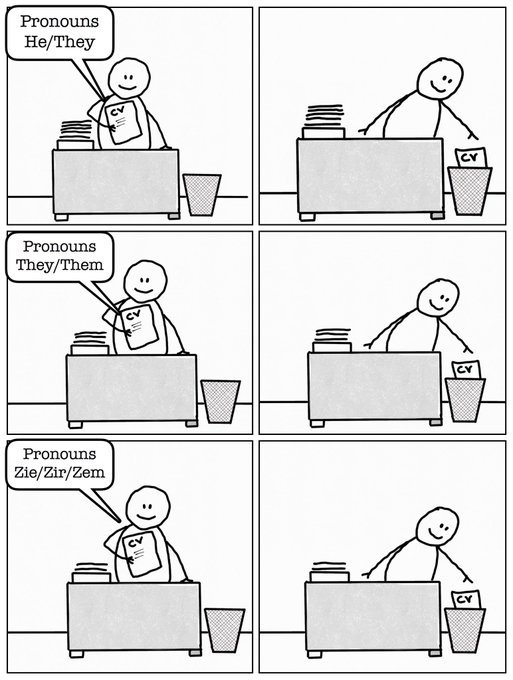
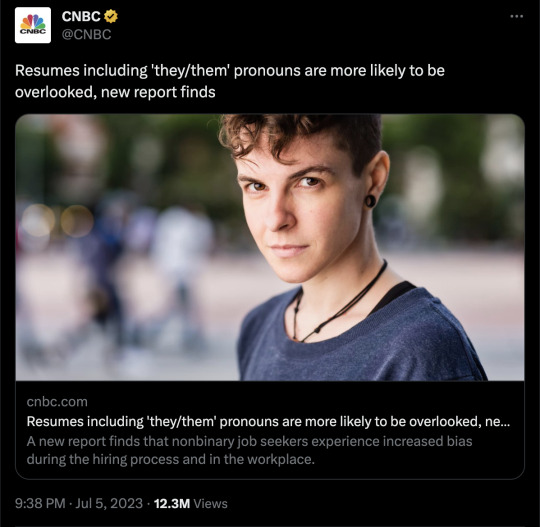
#gender ideology#pronouns#pronoun culture#nonbinary#pronouns in bio#LOL#funny#it's funny because it's true#attention seeking#narcissism#religion is a mental illness
21 notes
·
View notes
Text

"No one ever proved the non-existence of Zeus. People simply tired of worshiping him after 3000 years. Time kills all gods."
Your god is already dead. You just haven't figured it out yet.
#which god#many gods#so many gods#god is dead#zeus#man made god#god is man made#imaginary friends#religion is a mental illness
21 notes
·
View notes
Text
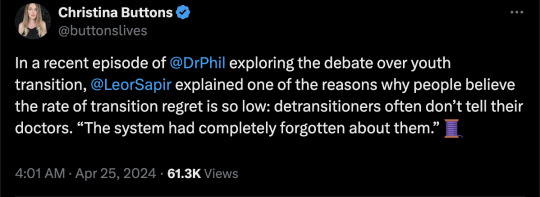

Abstract
The study’s purpose was to describe a population of individuals who experienced gender dysphoria, chose to undergo medical and/or surgical transition and then detransitioned by discontinuing medications, having surgery to reverse the effects of transition, or both. Recruitment information with a link to an anonymous survey was shared on social media, professional listservs, and via snowball sampling. Sixty-nine percent of the 100 participants were natal female and 31.0% were natal male. Reasons for detransitioning were varied and included: experiencing discrimination (23.0%); becoming more comfortable identifying as their natal sex (60.0%); having concerns about potential medical complications from transitioning (49.0%); and coming to the view that their gender dysphoria was caused by something specific such as trauma, abuse, or a mental health condition (38.0%). Homophobia or difficulty accepting themselves as lesbian, gay, or bisexual was expressed by 23.0% as a reason for transition and subsequent detransition. The majority (55.0%) felt that they did not receive an adequate evaluation from a doctor or mental health professional before starting transition and only 24.0% of respondents informed their clinicians that they had detransitioned. There are many different reasons and experiences leading to detransition. More research is needed to understand this population, determine the prevalence of detransition as an outcome of transition, meet the medical and psychological needs of this population, and better inform the process of evaluation and counseling prior to transition.
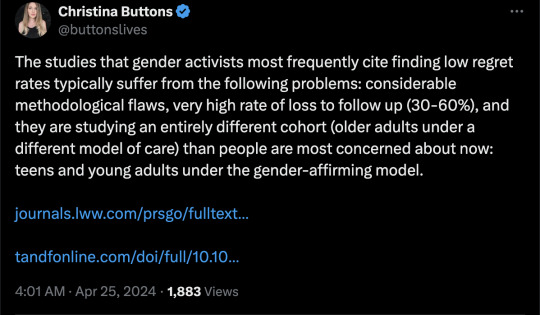
Sir,
Bustos et al1 aimed to measure the prevalence of regret following gender-affirmation surgery. Given the significant rise in young people seeking medical intervention for gender dysphoria, which can include surgery, outcome studies that accurately assess regret are of increasing importance. In this letter, we argue that the conclusions of their systematic review and meta-analysis are questionable due to limitations in their methods and shortcomings of the studies selected.
Starting with methods, the authors overlooked numerous relevant studies, including one of the best-known,2 raising questions about the adequacy of their search strategy. One study3 was inappropriately included as it only investigated regret regarding choice of surgical procedure, not of surgery itself. In addition, there are significant data extraction errors, leading to erroneous conclusions. For instance, the sample for surgical regret in their largest included study4 was inflated from 2627 to 4863, likely due to a miscalculation from a table reporting the treatment patterns of that paper’s total study population.
Besides these methodological inaccuracies, data in this field are often of low quality because of “lack of controlled studies, incomplete follow-up, and lack of valid assessment measures,”5 as well as the long amount of time regret can take to manifest (the average and median are estimated at 8–8.5 years2,4). Many of the included studies had participants with follow-up periods of only 1 or 2 years postsurgical transition. None appear to have a long enough follow-up period to reliably identify regret. The study contributing almost half of the participants4 explicitly noted their inclusion of participants with short follow-up time, relative to time to regret, and their large 36% loss to follow-up as limitations. These shorter studies only provide an estimated lower limit, as the large numbers of patients lost to follow-up add correspondingly large uncertainties to any quoted number.
Bustos et al1 acknowledge “moderate-to-high risk of bias in some studies.” Actually, this affects 23 of the 27 studies. The majority of included studies ranged between “poor” and “fair” quality: only five studies—representing just 3% (174) of total participants—received higher quality ratings. However, even these had loss to follow-up rates ranging from 28% to more than 40%, including loss through death from complications or suicide, negative outcomes potentially associated with regret.
A last and major concern involves sample selection. The cohort presenting with gender dysphoria today is substantially different from the cohort presenting during the research periods of the included studies. Further, there has been a significant liberalization over time of the criteria assessing readiness for surgery. Thus, the outcomes reported may be of limited relevance for estimating current surgery outcomes. Additionally, the generalization to “TGNB” populations seems unreliable, as it is based on an explicit sample size of only one “non-binary” patient. The authors do not address these issues.
In light of these numerous issues affecting study quality and data analysis, their conclusion that “our study has shown a very low percentage of regret in TGNB population after GAS” is, in our opinion, unsupported and potentially inaccurate.
Abstract
Two Dutch studies formed the foundation and the best available evidence for the practice of youth medical gender transition. We demonstrate that this work is methodologically flawed and should have never been used in medical settings as justification to scale this “innovative clinical practice.” Three methodological biases undermine the research: (1) subject selection assured that only the most successful cases were included in the results; (2) the finding that “resolution of gender dysphoria” was due to the reversal of the questionnaire employed; (3) concomitant psychotherapy made it impossible to separate the effects of this intervention from those of hormones and surgery. We discuss the significant risk of harm that the Dutch research exposed, as well as the lack of applicability of the Dutch protocol to the currently escalating incidence of adolescent-onset, non-binary, psychiatrically challenged youth, who are preponderantly natal females. "Spin" problems—the tendency to present weak or negative results as certain and positive—continue to plague reports that originate from clinics that are actively administering hormonal and surgical interventions to youth. It is time for gender medicine to pay attention to the published objective systematic reviews and to the outcome uncertainties and definable potential harms to these vulnerable youth.

Abstract
Introduction
Concerns about future regret and treatment discontinuation have led to restricted access to gender-affirming medical treatment for transgender and gender-diverse (TGD) minors in some jurisdictions. However, these concerns are merely speculative because few studies have examined gender-affirming hormone continuation rates among TGD individuals.
Methods
We performed a secondary analysis of 2009 to 2018 medical and pharmacy records from the US Military Healthcare System. We identified TGD patients who were children and spouses of active-duty, retired, or deceased military members using International Classification of Diseases-9/10 codes. We assessed initiation and continuation of gender-affirming hormones using pharmacy records. Kaplan-Meier and Cox proportional hazard analyses estimated continuation rates.
Results
The study sample included 627 transmasculine and 325 transfeminine individuals with an average age of 19.2 ± 5.3 years. The 4-year gender-affirming hormone continuation rate was 70.2% (95% CI, 63.9-76.5). Transfeminine individuals had a higher continuation rate than transmasculine individuals 81.0% (72.0%-90.0%) vs 64.4% (56.0%-72.8%). People who started hormones as minors had higher continuation rate than people who started as adults 74.4% (66.0%-82.8%) vs 64.4% (56.0%-72.8%). Continuation was not associated with household income or family member type. In Cox regression, both transmasculine gender identity (hazard ratio, 2.40; 95% CI, 1.50-3.86) and starting hormones as an adult (hazard ratio, 1.69; 95% CI, 1.14-2.52) were independently associated with increased discontinuation rates.
Discussion
Our results suggest that >70% of TGD individuals who start gender-affirming hormones will continue use beyond 4 years, with higher continuation rates in transfeminine individuals. Patients who start hormones, with their parents’ assistance, before age 18 years have higher continuation rates than adults.
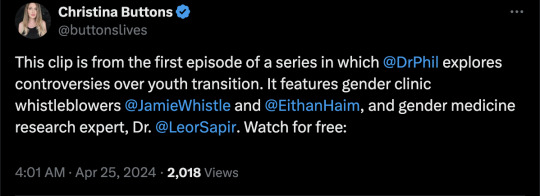
#Christina Buttons#Leor Sapir#Dr. Phil#Lisa Littman#detrans#detransition#transition regret#medical scandal#medical malpractice#medical corruption#evidence based medicine#gender affirming care#gender affirming healthcare#gender affirmation#religion is a mental illness
3 notes
·
View notes
Text
I was just on NewsNation and I was asked, "what should the Columbia University administration do?"
The answer is, consistent. Be consistent.
If people were chanting on campus to lynch the blacks, what would the administration do? If the black students were told by black leadership that they were not safe on campus and that they should Zoom into classes until it is safe to come back to campus, what steps would administration take?
Because those things have happened now to the Jews at Columbia.
So, what should campus administration do? Exactly the same thing you would do if people were calling for 10,000 October 7ths against the blacks.
Or 10,000 October 7ths against the LGBTQ community.
Or 10,000 October 7ths against fill in any other minority group.
What should the campus administration do at Columbia University?
Be consistent.
==
The fact that Columbia University administration is scared of the "protesters" - who believe they can act unilaterally and without repercussions - and what they would unleash if challenged and removed, tells you what you need to know about these students and their relationship to domestic terrorism.
terrorism | ˈterəˌrizəm |
noun
the unlawful use of violence and intimidation, especially against civilians, in the pursuit of political aims: the fight against terrorism | international terrorism.
#antisemitism#Columbia University#israel#pro hamas#hamas terrorism#hamas supporters#pro terrorism#palestine#pro palestine#terrorism supporters#domestic terrorists#religion is a mental illness
10 notes
·
View notes
Text
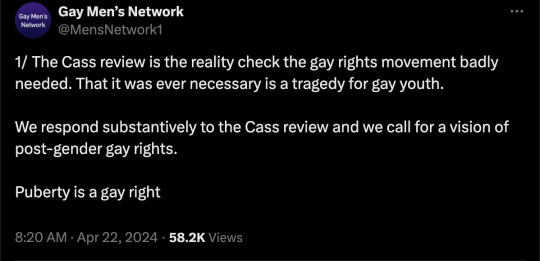


By: Gay Men's Network
Published: April 2024
Foreword
The final Cass Review is a devastating account of an unprecedented homophobic medical scandal in the NHS and private health sphere. Dr Cass details how an authoritarian brand of gender ideology came to replace evidence-based practice in the GIDS service. Whistleblowers like Susan Evans and Dr David Bell were silenced and cancelled. Brave detransitioner Keira Bell and Mrs A were forced to fight an arduous court case to expose elementary malpractice. Powerful former gay rights charities like Stonewall failed in their first duty of protecting samesex attracted youth, speaking in favour of a harmful ideology when they should have been opposing it. Those who did speak up for gay youth, like the LGB Alliance, were subject to misconceived and stressful litigation by ideological actors disinclined to discussion. The Cass Review may be a watershed moment for gay rights, but it is a damning indictment of gay politics that this reality check was ever necessary.
The recommendations of the Cass Review represent a return to the evidence-based norms of medicine. It is frankly terrifying they were ever abandoned in the first place. We wish to emphasise this was primarily a homophobic medical scandal. Staff at the Tavistock famously told a dark “joke” saying “soon there will be no gay people left”. Institutional homophobia must not be overlooked, edited out or erased from the post-Cass discussion. Homophobia ran riot because staff were too scared of accusations of transphobia.
With the exception that there be a clinical trial of puberty blockers, we welcome the recommendations of the Cass Review. Puberty is a human right and growing up into a welladjusted post-pubertal gay man is a gay right. Given mounting global evidence of testicular atrophy, increased testicular cancer risk, IQ deficits, osteoporosis, and more, GMN believes there are no circumstances in which a clinical trial having gay youth as live test subjects could be conscionable. We object to such in the strongest terms.
[ More... ]
==
Gender identity ideology: makes magical metaphysical claims about "essences" dissociated from physical reality; is profoundly anti-science; is authoritarian; is impervious to evidence; deems disbelievers to be heretics who are evil and dangerous; encourages adherents to separate from their normal relationships with family and friends; makes claims of an unattainable, incoherent utopia; regards the human body as a malleable, disposable vessel; reifies those who make the ultimate commitment; demonizes apostates (detransitioners); uses chanting and thought-terminating cliches ("TWAW"/"TMAM") to suppress doubt; pursues children as the most vulnerable and needing to be inducted.
It's a full-blown cult. And everybody has the right to freedom from this cult, like any religion.
It's not the end of gender ideology yet, but it's the beginning of the end.
#Gay Men's Network#Cass Review#Cass Report#homophobia#woke homophobia#homophobia 2.0#gay conversion therapy#gay conversion#conversion therapy#Tavistock#medical scandal#medical malpractice#medical corruption#puberty#puberty is a human right#puberty blockers#gender affirming healthcare#gender affirming care#gender affirmation#gender identity ideology#gender ideology#queer theory#intersectional feminism#religion is a mental illness#Youtube
7 notes
·
View notes
Text
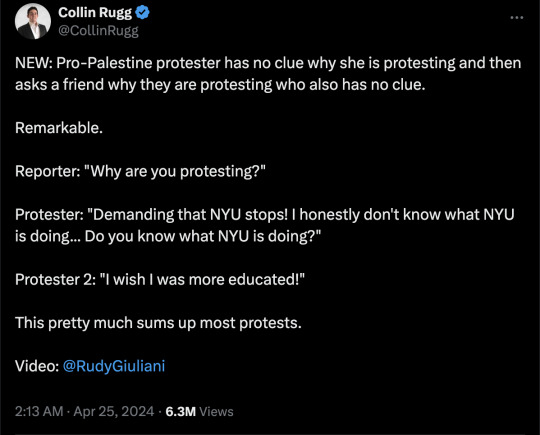

These NPCs are literal fucking morons. They don't have any values or ethics or beliefs of their own, only what they glean through osmosis from the mob mentality. Like the BLM riots of 2020, they just want to be seen to have the "correct" moral alignment.
Five minutes ago, these were the "punch a Nazi" people. "I was just following everyone else" is how the original Nazis rose.

The jihadis and terrorists love that these useful idiots are running interference for them, though.
Guaranteed that the ringleaders are the true believers, the Islamic supremacists eager to destroy Israel and exterminate the Jews, as Hamas themselves have declared. Some other proportion will be agitators who just want to engage in violence and destruction and are there for when it happens. The rest are just mindless drones who think they're going to be the stars of a cultural moment.
#antisemitism#hamas supporters#hamas#pro hamas#terrorism supporters#israel#pro palestine#palestine#pro terrorism#literal fucking morons#student protest#NYU#NYU protest#NPC#useful idiots#islam#jihad#jihadis#islamic terrorism#mob mentality#religion is a mental illness
16 notes
·
View notes